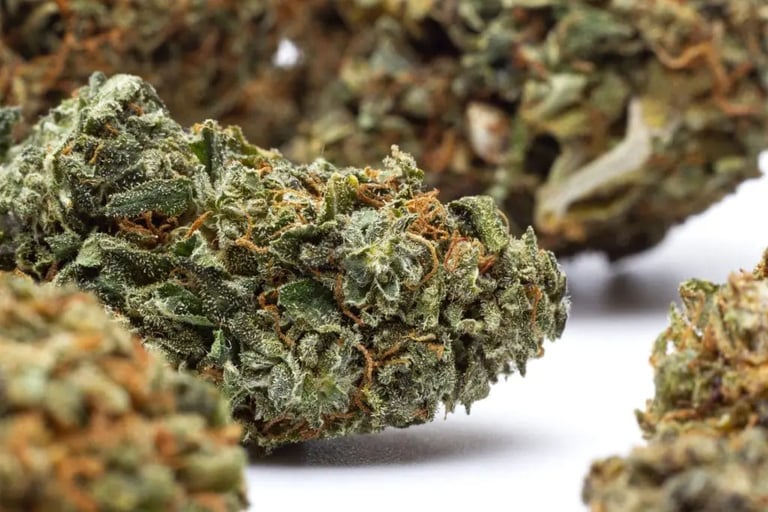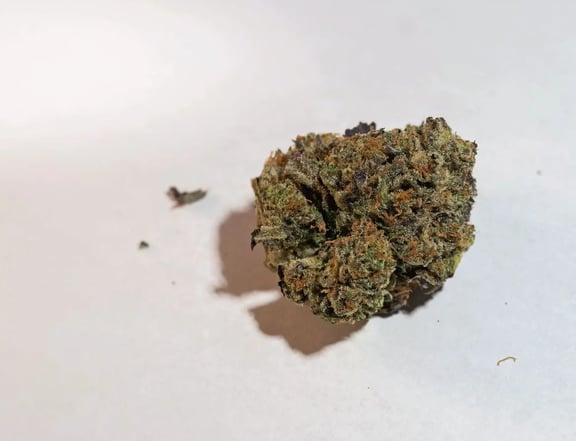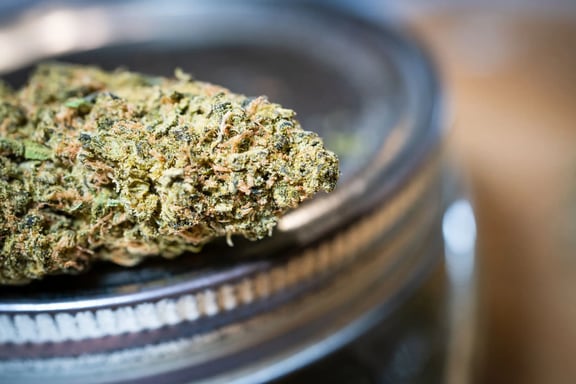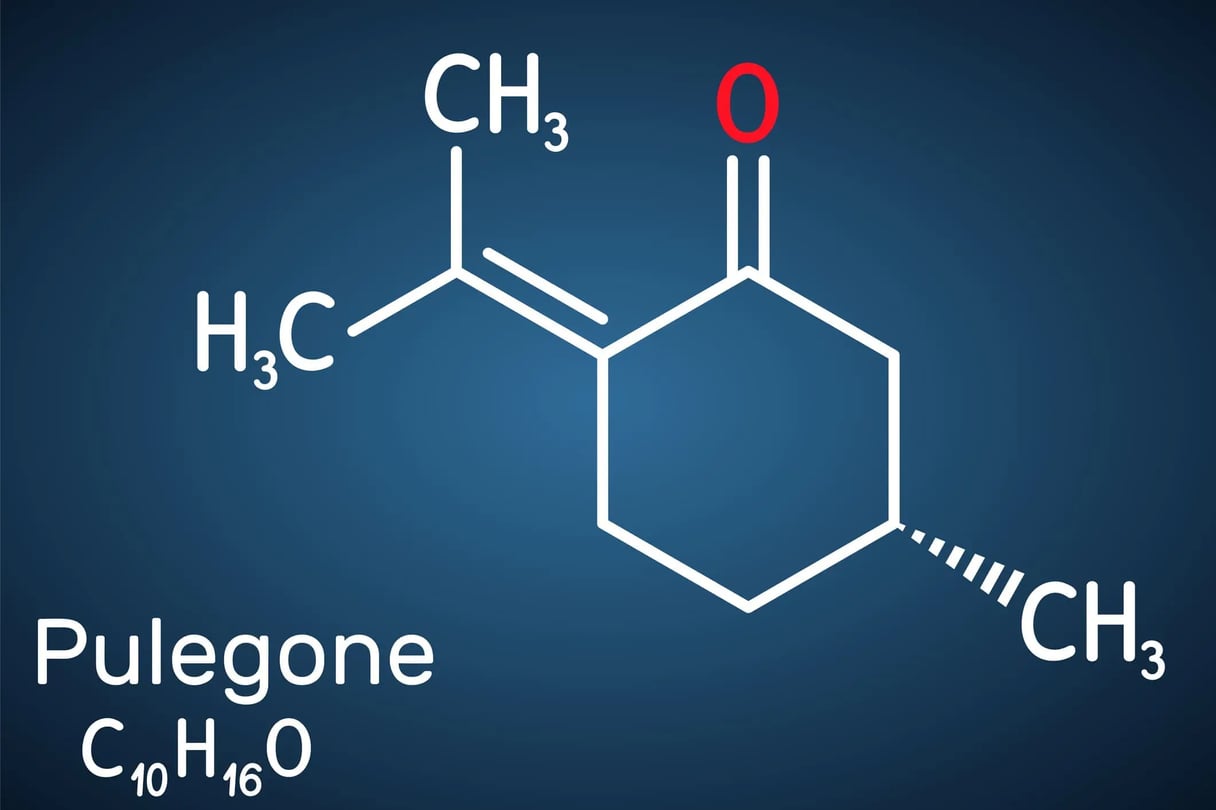
Want to Learn More About Cannabis Terpenes?
Explore the intricate world of terpenes; delve into their fascinating functionalities, and discover the diverse effects they offer.
Introduction
Delving into the aromatic world of cannabis, we uncover the essence of the pulegone terpene, a compound as intriguing as it is fragrant. The distinct peppermint aroma that pulegone imparts to the cannabis plant is merely the beginning of its journey through our senses and potentially, our wellbeing. Its properties extend beyond sensory pleasure, hinting at a realm of therapeutic possibilities that are anchored in its natural efficacy as a flavouring agent, perfume, and even an insecticide. As research unfolds, the effects of pulegone become increasingly significant, with studies exploring its capacity for memory enhancement, psychostimulatory, and anxiolytic activities within the context of the entourage effect in hemp.
The relationship between the pulegone terpene and cannabis is a tapestry of synergy and sensory richness. As a secondary terpene, it might appear in trace amounts, yet its contributions to the cannabis profile are unmistakable. The intriguing intersection of these aromatic pathways with health-related properties invites a closer examination of the pulegone terpene’s role in cannabis and its various expressions in the natural world.
Key Takeaways
Pulegone terpene is a secondary compound in cannabis with a potent peppermint aroma.
It has versatile uses, including as a flavour enhancer, perfume ingredient, and insecticide.
Research indicates potential therapeutic effects of pulegone, such as memory storage assistance and anti-anxiety properties.
The entourage effect is key in understanding how pulegone interacts with other cannabis compounds to enhance health benefits.
Pulegone’s presence, although in trace amounts, significantly influences the aromatic and flavour profile of cannabis.
Continuous research is vital to unlock the full potential and effects of pulegone terpene.
What is Pulegone?
Pulegone is a compound with distinct characteristics encompassing a sweet and minty aroma akin to menthol. As a liquid monoterpene, it boasts properties sought after in various industries. In botany, pulegone features prominently within the mint family, contributing to the characteristic scent and flavour that these plants are revered for. Beyond its delightful aroma, pulegone plays a central role in traditional remedies, offering relief for pain and common colds through its naturally occurring essence.
Its use in the natural world extends to being a mighty insecticide, though with great potency comes the need for cautious application. The compound’s efficacy as an insect repellent is matched by its potential toxicity at elevated levels, necessitating moderate use. In a nod to the holistic synergies within hemp, pulegone is present, albeit in trace amounts, accentuating the entourage effect that defines the interactions of compounds within this versatile plant.
A sweet, minty aroma that distinguishes pulegone as a key monoterpene
Valued for its enhancement of scent and flavour — particularly within the mint family
Historical applications in easing discomfort from colds and pain
Recognised as a potent natural insecticide, though caution is advised due to possible toxicity at high dosages
Contributes to the subtler nuances of the sensory profile in some hemp strains
The Therapeutic Potential of Pulegone
The medical benefits of pulegone have been a subject of interest within traditional healing practices for centuries. A compound known for its sweet, minty aroma, pulegone forms the essence of pennyroyal oil, a natural remedy historically utilised for its soothing effects on colds, headaches, indigestion, and menstrual symptoms. More recently, scientific attention has gravitated towards the psychoactive capacities of this intriguing terpene, specifically investigating its anti-anxiety effects and potential to act as a psychostimulant within the nervous system.
An animal study conducted in 2014 illuminated the versatility of pulegone’s therapeutic profile, revealing not only its calming anti-anxiety properties but also suggesting a complementary psychostimulant action. These findings from animal study research indicate a duality that could prove revolutionary in the treatment of mental and mood disorders. However, it’s pertinent to acknowledge that this preliminary evidence necessitates extensive human research to confidently position pulegone within the pharmacopeia for human conditions.
Historical use of pulegone in treating traditional maladies highlighting its medical value.
Demonstration of anti-anxiety effects in preclinical, animal-based studies.
Emerging evidence of psychostimulant capabilities suggesting a multifaceted impact on cognitive and motor functions.
A call for rigorous research trials to validate these animal study findings for human therapeutic application.
As the scientific community continues to unravel the molecular complexities of natural compounds, the role of pulegone in health and wellness (especially medical cannabis) remains a captivating chapter in the exploration of herbal medicine’s meeting with modern science.
Understanding the Safety Profile of Pulegone
As we explore the dynamic presence of pulegone in various products, it is imperative to understand the dichotomy between its natural benefits and potential risks. Recognised for its natural therapeutic potential, pulegone nevertheless demands cautious usage due to its inherent toxicity risks when consumed in large quantities. Integral to promoting safe usage of pulegone is the awareness of the FDA regulation that distinguishes synthetic pulegone as unsuitable for use as a food additive, basing this decision on the concerns regarding pulegone toxicity. Yet, the FDA allows the use of natural pulegone, with the provision that it must be incorporated in small, regulated quantities as a natural flavour.
Given the potential for pulegone toxicity, individuals turning towards essential oils and other concentrated forms that contain pulegone must do so with prudence. Guidance from healthcare professionals is highly recommended to ensure safe usage, avoiding any adverse reactions that could stem from improper handling or overconsumption. Adhering to these guidelines not only safeguards against toxic effects but also allows for the therapeutic aspects of pulegone to be enjoyed responsibly.
Employ vigilance with pulegone-containing products due to potential toxicity.
Note that synthetic pulegone has been prohibited in food items by the FDA.
Ensure natural pulegone is utilised only in small, regulated amounts as stipulated.
Seek healthcare guidance for safe usage, particularly with essential oils and concentrated forms.
Natural Sources of Pulegone: Beyond Cannabis
When venturing through the green tapestry of aromatic terpenes, one encounters the invigorating presence of pulegone-rich plants. Renowned for its refreshing peppermint note, pulegone is a ubiquitous attribute not solely confined to the verdant foliage of cannabis. This potent aromatic terpene extends its reach far beyond, pervading a diverse array of natural sources that comprise mint family members and more.
Pulegone’s evocative minty and subtly sweet fragrance serves as a botanical beacon, luring pollinators to their hosts while simultaneously warding off undesirable pests. This dual functionality is not just advantageous for plant survival but is also poised to elevate human sensory experience. The olfactory allure of pulegone is essential in the biological signature of several herbs, rendering them not just components of the natural landscape but also key contributors to our olfactory appreciation of nature.
Peppermint (Mentha × piperita): A classic example of a pulegone-bearing herb, peppermint’s invigorating scent is in part due to its pulegone content.
Catnip (Nepeta cataria): Beloved by felines worldwide, catnip is another natural repository of pulegone, adding complexity to its characteristically engaging aroma.
Pennyroyal (Mentha pulegium): Embraced in folk medicine, pennyroyal boasts significant quantities of pulegone and is traditionally harnessed for its sedative qualities and its reported efficacy in mitigating dizziness.
These pulegone-rich plants extend their utilities beyond their ornamental, ecological, and aromatic terpene benefits. Historically, they have imbued their intrinsic therapeutic essence into traditional remedies and practices, showcasing the versatility of this remarkable natural compound. While the narrative of pulegone within cannabis cultivars warrants considerable attention, its prevalence in the broader botanical sphere is a testament to its importance in both nature and human utilisation.
The Synergy Effect: Pulegone’s Interaction with Other Cannabis Compounds
Within the verdant folds of cannabis resides pulegone, a terpene that, though present only in trace amounts, contributes significantly to the plant’s aromatic complexity and its healing aptitudes. The entourage effect, a term coined to describe the synergistic interaction between cannabinoids and terpenes, elegantly encapsulates the combined effect of these compounds, potentially augmenting the therapeutic efficacy of cannabis products.
The notion of cannabinoid-terpene synergy plays a critical role in pulegone’s contribution to the cannabis experience. As a secondary terpene, pulegone infuses a quintessential minty fragrance into the aroma profile of some of the best cannabis strains, simultaneously enhancing their flavour. This nuanced addition, subtle though it may be, is key to the holistic effect that can amplify the remedial properties sought after by both connoisseurs and patients alike.
Pulegone enriches the sensory experience of cannabis through its mint-infused aroma.
Its synergistic potential may intensify the healing properties of hemp products, adhering to the principles of the entourage effect.
Understanding pulegone’s role elucidates the intricate weave of cannabinoid-terpene interactions, crucial for advancing cannabis science and its applications.
As research further investigates these interactions, the depth of pulegone’s impact on the therapeutic landscape of cannabis continues to emerge, inviting a broader appreciation for the subtleties of terpene contributions and their importance in the overall efficacy of hemp-derived products.

Pulegone in Everyday Products
The quintessence of pulegone permeates our daily lives, often without fanfare, yet in ways that enrich our sensory experiences. Notably approved as a food additive in its natural form, pulegone uses extend to imparting a refreshing minty flavour to a variety of everyday items. Its subtly sweet aroma and taste are cherished across numerous products containing pulegone, some of which form part of our routine indulgences and comfort rituals.
Peppermint Candies: These sweet treats owe their classic, refreshing zest to the natural inclusion of pulegone, elevating a simple confection to a palate-cleansing favourite.
Baked Goods: From an array of artisanal bread to delectable pastries, the addition of pulegone enchants these baked delights with its signature minty undertone.
Alcoholic Beverages: The mixology arts have embraced pulegone to infuse cocktails with an invigorating twist, demonstrating its versatility in flavour profiling.
Aromatherapy Products: In the pursuit of tranquillity, pulegone-laden essential oils are used to diffuse a cool, calming scent, promoting relaxation and mental clarity.
Perfumes: As an olfactory cornerstone, pulegone contributes to the fresh, clean accords found in a myriad of perfumes, intricately blending with other aromatic components.
Embraced by various industries for its innate aromatic and flavour characteristics, the presence of pulegone in products enhances consumer experience, serving both functional and therapeutic purposes.
Research Insights: Current Studies on Pulegone
Recent pulegone research offers promising insights into its potential health benefits, particularly concerning its anti-hyperalgesic effects and analgesic properties. This compendium of studies delves into the efficacy of pulegone as a natural remedy for managing pain, aligning with its historical usage within traditional medicine.
Monoterpenes like pulegone are garnering interest due to their capacity to mediate inflammatory responses. Indeed, the analgesic potential of pulegone has been underscored through various research initiatives, focusing on conditions characterised by heightened sensitivity to pain, such as rheumatoid disorders.
Analyses of pulegone’s anti-inflammatory actions have observed its ability to mitigate inflammation markers, a step towards validating its role in pain management strategies.
In vivo studies have demonstrated pulegone’s capacity to relieve hyperalgesia, providing a tangible measure of its analgesic efficacy.
Further examination of pulegone’s interaction with inflamed biological systems reveals a nuanced understanding of its therapeutic footprint.
As the scientific community progresses, these preliminary findings lay the groundwork for more in-depth exploration into how pulegone can be integrated into modern medicinal practices. Such endeavours seek not only to corroborate pulegone’s traditional uses but also to expand its application across a spectrum of pain-related conditions.

Pulegone’s Influence on Cannabis Aroma and Flavour
The scent and savour that pulegone imparts to certain cannabis varieties play a pivotal role in the cultivation of their unique aroma profile and flavour enhancement. Not as ubiquitous as the myrcene or limonene terpenes, pulegone still stands out for its singular contribution to the overall terpene profiles of these plants. The minty essence, pulling reminiscences of fresh peppermint, is one of the defining characteristics of strains that include this secondary terpene. While only a minor cannabinoid, it can be found in some indica and sativa cultivars, and also certain hybrid weed strains.
An exploration into the aromatic intricacies of cannabis reveals that the terpene profiles comprising pulegone are not just a matter of olfactory pleasure; they could potentially influence the therapeutic qualities inherent in the plant. This mint-infused aroma elevates the sensory consumption experience and may play a role in the nuanced modulation of hemp’s remedial applications.
Integral to the multi-layered fragrance of cannabis, pulegone enriches the aroma profile.
Its capacity for flavour enhancement contributes a refreshing burst to the tasting experience.
Despite its less dominant presence, pulegone’s interactions amplify the complexity of terpene profiles.
A study into the subtleties of cannabis aroma reveals that pulegone’s influence extends beyond its scent and flavour contributions, implying potential synergistic effects within the plant’s chemical makeup. It’s this synergy that arouses curiosity and anticipation within the realms of both connoisseur appreciation and therapeutic exploration.
Conclusion
In the realm of cannabis, pulegone stands out as a monoterpene of considerable intrigue, earning its place through its pronounced peppermint scent that adds to the complex aromatic tapestry of the plant. This pulegone summary elucidates its natural occurrence in a variety of sources and the significant potential it holds within therapeutic applications. With evidence pointing towards its anti-anxiety and analgesic properties, pulegone is poised to become an increasingly important subject in future pulegone research.
While its benefits to the fragrance and flavour profiles of cannabis are undeniable, so too is the necessity for mindful application to avoid potential toxicity from excess use. As we assess the cannabis terpene benefits, the dual nature of pulegone—as both a blessing to the sensory experience and a compound demanding respect and caution—is ever-present. It’s a delicate balance, reflective of the broader responsibility to harness natural remedies while understanding their limitations and implications.
As enthusiasts and experts alike anticipate the unfolding chapters of pulegone’s story, the emphasis remains on informed exploration. The value of moderation, guided by scientific inquiry and regulatory wisdom, is clear as pulegone integrates into a myriad of aromatic and culinary delights. Through continued observation and study, we approach a future where pulegone’s role is both safely managed and maximised in benefit, reinforcing its stature within the diverse world of natural terpenes.
Pulegone FAQs:
-
Pulegone is a secondary monoterpene known for its strong peppermint aroma, identified in cannabis and other natural sources. It plays a significant role in the entourage effect in hemp, potentially enhancing the aromatic, flavourful, and therapeutic qualities of the plant.
-
Yes, pulegone is abundantly present in various plant species, especially those from the mint family, such as peppermint, catnip, and pennyroyal. These plants use pulegone to attract pollinators and repel pests.
-
Pulegone imparts a refreshing mint flavour to everyday products such as peppermint candies, baked goods, and some alcoholic beverages. It is also present in aromatherapy items and perfumes, offering a cool and fresh scent experience
-
The entourage effect refers to the synergistic interaction between cannabinoids and terpenes in cannabis that enhances the plant’s overall efficacy. Pulegone contributes to this effect by adding a minty aspect to the flavour and scent profiles of certain cannabis strains, potentially amplifying their healing properties.
-
Pulegone contributes to the distinctive minty fragrance and taste of some cannabis strains, enhancing overall terpene composition. While not as prevalent as other terpenes, it adds to the intricate aromatic and flavour notes, influencing the therapeutic qualities and consumer preference for these strains.












.jpg)